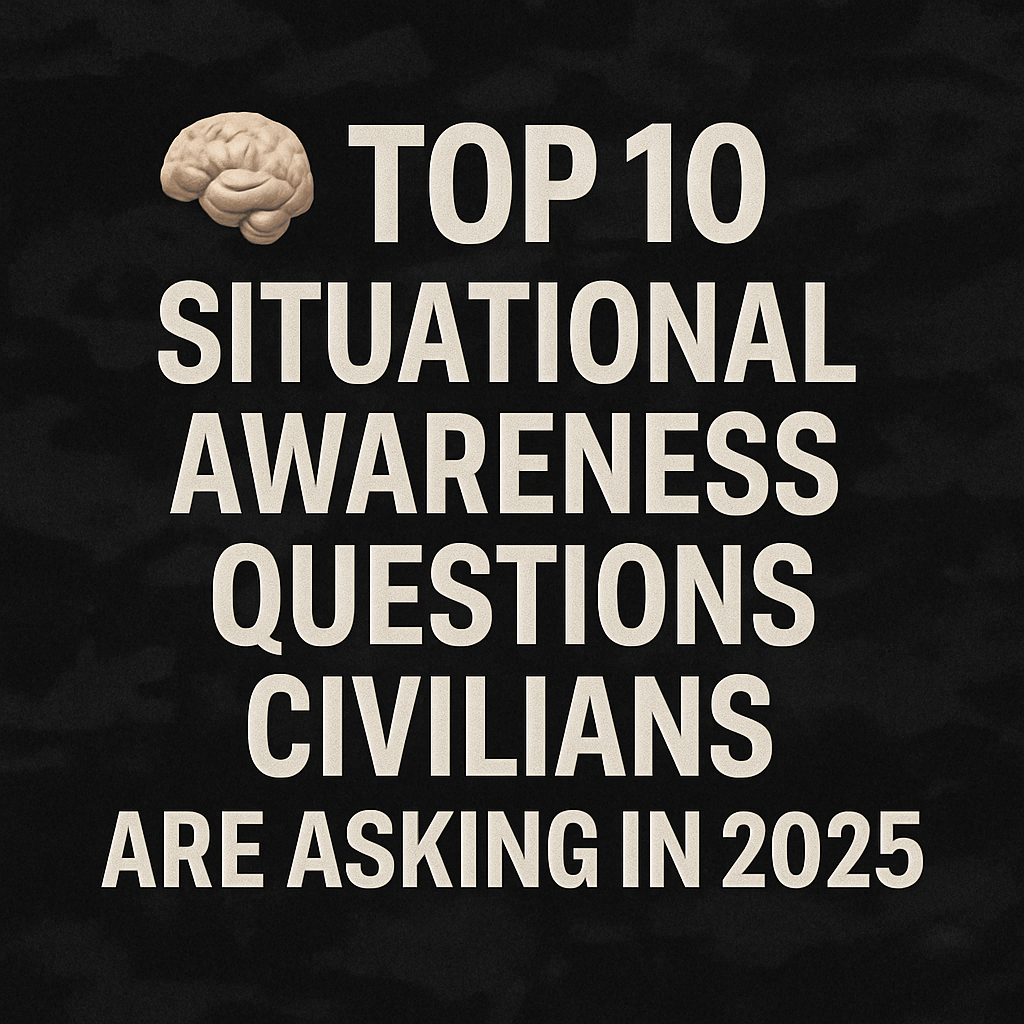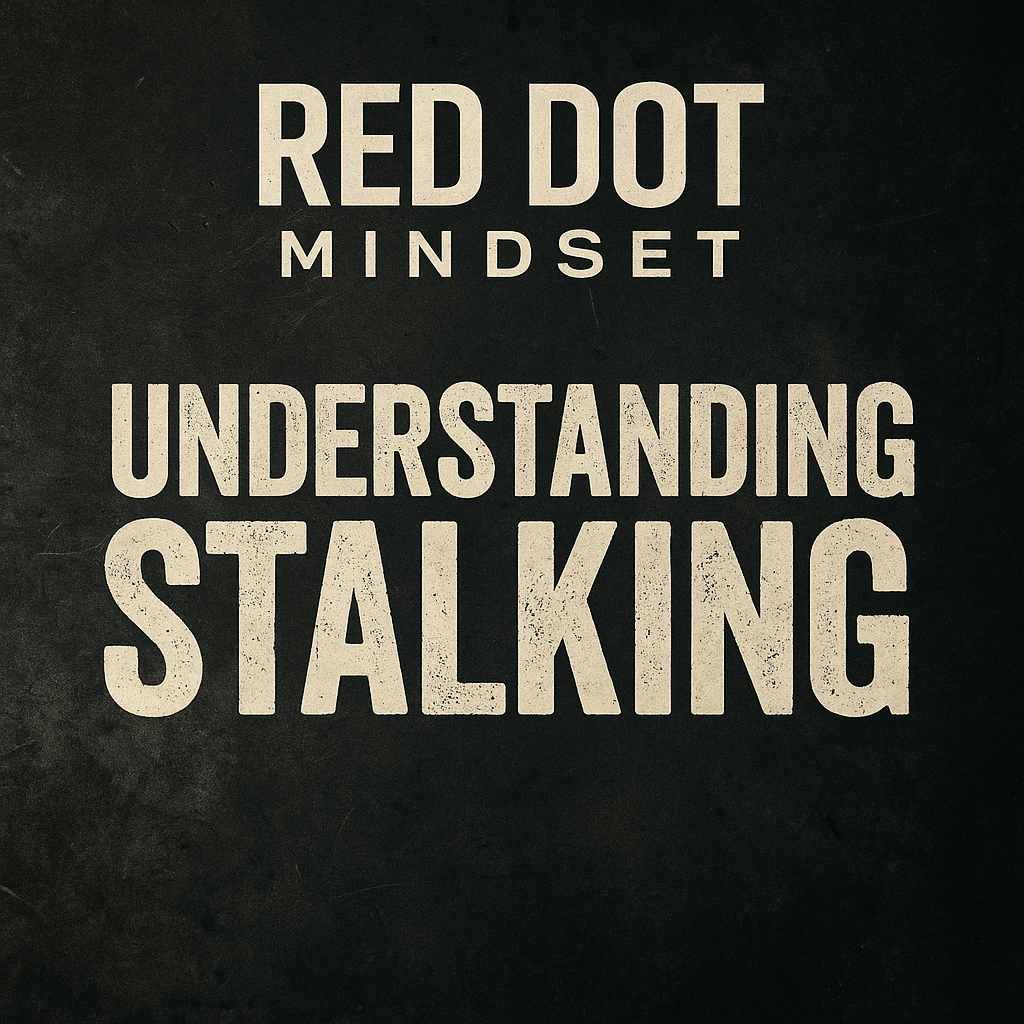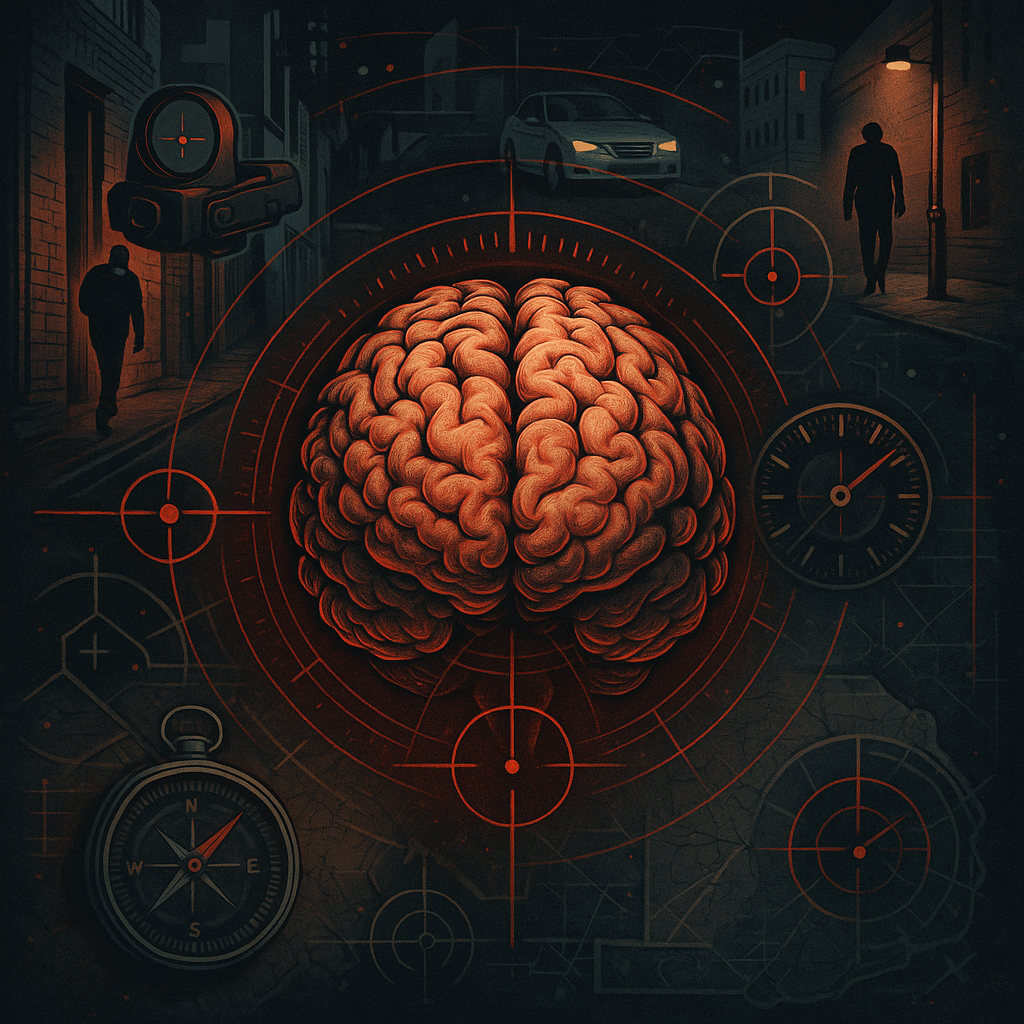Episode Transcript
[00:00:00] Speaker A: You know, imagine you're leaving your favorite coffee shop. Maybe your hands are full, mind's wandering a bit. Are you really seeing what's around you? Or maybe you've slipped into what some call condition White without even realizing it.
Today we're doing a deep dive into something pretty foundational for modern life. Yes, street level personal safety strategies for civilians. Specifically looking at 2025. And this isn't about fear, right? It's about empowerment through awareness.
[00:00:26] Speaker B: Exactly. And you know, more and more people are asking about this and for good reason. Our goal here really is to cut through the noise, give you clear, actionable insights.
[00:00:35] Speaker A: Yeah. Our mission for this deep dive is to give you, the listener, a direct shortcut to being genuinely well informed about personal safety. We're pulling some crucial insights from civilian situational awareness. Top questions answered. That's from Gray Matter Ops and Red Dot mindset.
And the core message from Mickey Midow. He's a 24 year USAF Security Force vet behind Gray Matter Ops. He always emphasizes this mindset, not muscle wins the fight.
[00:01:01] Speaker B: That really is the truth of it. This isn't about being paranoid all the time, it's just about being prepared. We're going to keep this conversation, you know, calm, informed and genuinely empowering. Actionable stuff you can use right away, no unnecessary jargon.
[00:01:14] Speaker A: And I'm here as your guide, you know, genuinely curious, to unpack these vital safety questions. I'm ready to learn right alongside you.
[00:01:21] Speaker B: And I'll be here to help translate these ideas into well, clear, actionable strategies, making sure you understand not just the what, but the why behind these skills so you can really train your mind before the moment hits.
[00:01:34] Speaker A: Okay, let's jump right in then. We've got this fantastic resource tackling the top 10 questions civilians are asking about personal safety in 2025. And where better to start than with that, that gut wrenching feeling? How can I tell if someone is following me? And maybe more importantly, what do I do about it? It's such a common unease. But sometimes it's more than just a feeling, isn't it?
[00:01:55] Speaker B: It absolutely is. Your intuition is powerful. The key is learning to confirm that feeling and then knowing your next steps. The signs are usually pretty distinct. You might, you know, see the same person or the same car popping up repeatedly, or you notice they're mirroring your movements like they change direction when you do, or speed up or slow down with you. They might also be lingering nearby without any obvious purpose or just seeming to appear out of nowhere again and again.
[00:02:22] Speaker A: Okay, so if that feeling pops Up. How do you sort of test it without making a big scene or maybe putting yourself in more danger?
[00:02:30] Speaker B: That's a really good question. You test it subtly. If you're walking, change your direction suddenly or your speed, or just cross the street. You could even reverse your path completely for a bit. If you're driving, a classic test is making four consecutive right turns.
If they're still behind you after that, well, that's a very strong indicator. Yeah. Another simple tactic, walk into a busy store and just observe. If they follow you in and keep tracking you inside, well, your suspicion is likely confirmed.
[00:02:57] Speaker A: And if it is confirmed? If you're pretty sure, what's the immediate action plan?
[00:03:02] Speaker B: Right.
First, stay calm. That's a paramount. And this is critical. Do not go home. Don't leave them there.
[00:03:10] Speaker A: Right. Don't lead them to your safe space.
[00:03:11] Speaker B: Exactly. Your home is where they get the most info about you and potentially where you're most vulnerable. Instead, head straight to a very public, well lit place. Think a gas station with attendants, a firehouse, a busy shop. While you're moving, call 911 and also call a trusted contact. Tell them exactly where you are and what's happening. But the most vital point here, avoid confrontation at all costs.
[00:03:35] Speaker A: Okay?
[00:03:35] Speaker B: Your only focus should be escaping the situation and reporting it. Think about that solo traveler scenario. She uses those tact turns to confirm she's being followed in a foreign city. But she doesn't confront them. She doesn't go back to her hotel. She goes straight to the nearest police station. That's the mindset.
[00:03:51] Speaker A: Confirm, don't confront, get to safety.
That makes a lot of sense.
And okay, once you've maybe confirmed that intuition or even just thinking preventatively, a lot of listeners are probably wondering, what can I actually use if avoidance fails? So let's talk tools.
Self defense tools. What's considered the best, legally speaking for civilians right now?
[00:04:14] Speaker B: Well, what's often overlooked and what's really interesting here is that the best tool isn't one specific thing. It's the one you can legally carry, the one you actually train with consistently, and the one you can get to quickly and reliably when you're under immense stress. Okay, and this is where we absolutely have to put in that critical legal disclaimer, straight from Gray Matter Ops.
Always check your local and state laws.
[00:04:37] Speaker A: Always super important.
[00:04:38] Speaker B: They vary wildly, they change all the time, and what's perfectly legal on one side of the street might get you into serious trouble on the other.
[00:04:44] Speaker A: That's a huge point. Knowing your local laws is Non negotiable.
So keeping that in mind, what are some of the tools people often consider?
[00:04:52] Speaker B: Well, pepper spray or OC or gel aversions are very common, widely legal in most places. Pretty compact, effective, relatively low risk. But what people often miss is you still need to practice aiming it. And you've got to be aware of the wind direction that can make it useless or even blow back on you.
[00:05:09] Speaker A: Right. Didn't think about the wind.
[00:05:10] Speaker B: Yeah. Personal alarms, legal everywhere. Great for drawing attention, which can be a really strong deterrent, but they won't physically stop an attacker. Stun guns and tasers, legal in many states, but not all tasers give you some distance. Stun guns need very close contact. Both definitely need training. Serious training is recommended.
[00:05:29] Speaker A: And what about things that might seem less like obvious weapons? Maybe everyday items?
[00:05:35] Speaker B: Exactly. Things like tactical pens or Kubotans, generally legal, pretty discreet, but again, they need specific training and close range use to be effective at all. Knives, highly regulated, carry a high risk of things escalating badly. And they require very serious training and a clear understanding of use of force laws. Then of course, firearms. They come with a significant legal and regulatory burden, as they should.
They can be effective if you're extensively trained. But you absolutely must keep them secure, practice constantly, and be mentally prepared for that level of responsibility.
The surprising truth sometimes is that a simple legal flashlight, one you've trained with, know how to use and can grab instantly. Optum beats a high tech tool you're not good with or can't legally carry. It's about consistent readiness.
[00:06:23] Speaker A: It's so clear the tool is just one piece. The mindset behind it may be even more critical. And that's really where the rubber meets the road, isn't it? Knowing what to do is one thing, but how do we actually train ourselves? Yeah, how do we stay calm and decisive when the pressure really hits?
[00:06:37] Speaker B: Look, when it comes down to it, your mental game, that's the absolute foundation. It's everything in personal safety. All the gear in the world is secondary to having that right mindset. We talk a lot about training your brain before the moment. The classic framework for this, and many listeners might know it, is the Cooper color code. Just as a quick refresher, it gives you a mental framework for your awareness level.
[00:06:57] Speaker A: Yeah, let's walk through those colors again.
[00:06:58] Speaker B: Okay. It starts with condition white. That's completely unaware, vulnerable, maybe head boried in your phone. Total obliviousness.
[00:07:05] Speaker A: We've all been there.
[00:07:06] Speaker B: Oh, absolutely. Then condition yellow. This is where you want to live. Mostly relaxed, alert, aware, of your surroundings, Noticing little details. Not paranoid, just present. Condition orange means you've spotted something specific, a concern, and you're actively thinking, okay, what if? What's my plan?
And finally, condition red. That's when you're executing that plan, taking decisive action because the threat is immediate. The really profound takeaway here isn't about living in fear or being hypervigilant 24 7. It's about making condition yellow your baseline, Recognizing when things shift to orange, and then being ready to respond effectively in red if you absolutely have to.
[00:07:47] Speaker A: That seems like a really practical way to think about your mental state. And I know gray matter ops has kind of evolved that concept further specifically for civilians.
How do those newer models build on Cooper's original idea?
[00:07:59] Speaker B: They absolutely have. Gray matter ops developed the gray white black model, and it's designed specifically for civilians. It sort of simplifies the dynamic. White still means unaware, disconnected from what's happening around you. Black represents the threat actors, those people actively looking to exploit weakness or vulnerability. Okay, the critical insight, the link, is that the unaware white are the ones often targeted by the violent black.
Our goal, your goal, should be to operate in the gray, vigilant, prepared civilians who live, as we say, left of bang.
[00:08:33] Speaker A: Left of bang. What does that mean exactly?
[00:08:35] Speaker B: It means you're not just reacting to the crisis, the bang. You're making small, smart choices before an incident even gets a chance to happen. It's about spotting those early warning signs and making a move, changing your path, leaving the area to prevent the bang entirely. It's proactive. This model really empowers civilians to sh into preparedness, but without tipping over into paranoia.
[00:08:57] Speaker A: Okay, so that's the framework. How do you actually practice that? What are some concrete techniques for this? Training the brain before the moment.
[00:09:04] Speaker B: Right. We recommend stress inoculation. And like this isn't just for soldiers or police officers. For civilians, it can be as simple as mentally rehearsing your emergency exit plan every single time you walk into a new building or practicing a quick de escalation phrase out loud. It's about getting your brain used to thinking calmly under pressure, so when real stress hits, you're not completely frozen. You have a starting point. Diaphragmatic breathing, Deep belly breathing is incredibly effective too. It physically calms your nervous system, helps manage that adrenaline dump. Okay, and visualization, really important, Mentally reverse what ifs in everyday places. Picture yourself noticing something, assessing it, and responding calmly and decisively. See yourself succeed, you know, for more.
[00:09:47] Speaker A: Deep dives into these specific mindset models like the Cooper Codes or gray, white, black, and how you can really implement them day to day. You can always visit www.redupmin.
it really is fascinating how these frameworks help you train the mind before the moment. Which actually leads perfectly into our next thought.
What does situational awareness actually look like in daily life? How does it show up beyond just, you know, thinking about colors?
[00:10:13] Speaker B: That's a great question, because it's definitely not about, you know, tactical cosplay or walking around expecting trouble at every corner.
[00:10:19] Speaker A: Right.
[00:10:20] Speaker B: It's simply about presence, observation, and a little bit of prediction.
In daily life, this translates to small, consistent actions. Like when you enter a room, you're not just finding a chair, you're subtly scanning where the exits are, noticing who's near them. Just a quick glance. You start watching for unusual behavior. Someone loitering with no clear reason, someone trying hard to cover their face when it's not cold, or even someone displaying really extreme emotions that seem out of place for the setting.
[00:10:48] Speaker A: So it's about being really present, not just physically there, but mentally processing what's happening around you constantly.
[00:10:54] Speaker B: Exactly that. That. It's about building smart habits. Little things.
Don't sit with your back completely exposed to the main entrance in a restaurant or coffee shop. If you can help it, always monitor hands, people's hands. That's usually where a direct physical threat originates from. You train these small observations daily, make them automatic, like breathing.
Awareness becomes a lifestyle, not just some tactic you switch on when you feel scared.
Think about that commuter example spot. Someone just hanging out by a gas pump late at night. Feels a little off. Instead of shrugging it off, they shift from yellow to orange, mentally decide nope, and drive to the next station.
[00:11:31] Speaker A: And avoids a potential problem.
[00:11:33] Speaker B: Exactly. Avoids a potential setup entirely just by listening to that little internal ping and making a proactive choice. That's awareness in action. It's the difference between being reactive and being proactive.
[00:11:45] Speaker A: That story really drives home how simple, consistent looking can make such a difference.
Now our next point touches on something important. Acknowledging that some risks, unfortunately, can disproportionately affect certain groups. It's a question we get a lot. What specific safety tips should every woman know when moving through public spaces?
[00:12:05] Speaker B: Yeah, and while all the advice we've talked about applies to everyone, there are definitely some practices that are particularly vital for women. First and foremost, maybe most importantly, trust your gut and crucially, act on it. If something feels wrong, off, creepy, it probably is. Don't dismiss that feeling.
[00:12:22] Speaker A: Don't rationalize it away precisely.
[00:12:24] Speaker B: Walk with confidence. Head up Shoulders back, purposeful stride. Just your posture and demeanor can make you appear less like an easy target.
[00:12:31] Speaker A: You project awareness in those common distractions we keep mentioning. Headphones, phones. They seem even more critical to avoid here.
[00:12:38] Speaker B: Absolutely. Without a doubt. Avoid loud music and headphones that completely blocks out your hearing. Resist that urge to text while walking, especially in those transition zones. Parking lots, stairwells, walking to or from your car or public transport.
[00:12:51] Speaker A: Right. Those moments of distraction make you incredibly vulnerable. Stick to populated, well lit areas whenever possible.
Actively avoid those isolated shortcuts, even if they seem quicker. Vary your routes and your routine. Sometimes predictability can be exploited. And finally, if you do choose to carry a legal self defense tool, make absolutely sure it's one you've trained with properly and consistently and that you can access it quickly, smoothly, under stress. That last part, the access under stress, is often overlooked.
[00:13:21] Speaker B: That makes sense. Practice makes permanent okay, speaking of potentially more vulnerable groups, our next question is a really sensitive one, but so important for listeners who are parents.
How do I teach situational awareness to my kids without completely scaring them?
[00:13:35] Speaker A: This is a fantastic question, a very common concern, and the approach here is absolutely key. The goal is to teach kids using confident, calm repetition. Focus on empowerment, not on making the world seem terrifying. Gray Matter Ops specifically recommends establishing a family code word.
[00:13:53] Speaker B: A code word? Yeah, a secret word that only the immediate family and maybe one or two absolutely trusted adults know. If someone approaches your child, even someone the child vaguely recognizes, and they don't know that specific code word, the child knows immediately. This person is absolutely not safe to go, with no exceptions.
[00:14:10] Speaker A: Wow, that's such a brilliant, simple tool for a child. So concrete. What other practical things can parents do?
[00:14:17] Speaker B: Practice what if safety drills, but do it casually. Make it feel like a game or like solving a little puzzle together. Instead of don't ever talk to strangers. They're bad.
Frame it as building skills. Ask hey, what if someone you didn't know offered you candy at the park? What would be our smart move? Make it empowering. Teach digital safety early on too. No sharing personal info online, even in games or chat rooms. Use pickup passwords for school or daycare. Make sure the kids know exactly who is and isn't allowed to pick them up. And of course, train that basic situational awareness with them in everyday settings. Heads up, phones down. Even in seemingly safe places like the grocery store or playground, just notice who's around. The core message is always awareness builds confidence, and confidence pushes back against fear. We've heard stories, sadly, real ones, where a mom taught her Kids, the family code word. And it literally stopped an abduction attempt cold right at school pickup.
[00:15:12] Speaker A: Chilling, but powerful.
[00:15:14] Speaker B: That's the power of these simple proactive tools. They work.
[00:15:17] Speaker A: That's a truly powerful example.
[00:15:18] Speaker B: Wow.
[00:15:19] Speaker A: Okay, shifting gears slightly for our seventh point, let's talk about avoiding direct confrontation altogether.
What can I do? What can you, the listener, do to avoid getting ambushed, mugged, or just caught completely off guard?
[00:15:32] Speaker B: Right. Most ambushes, most muggings, they succeed precisely because the victim was, well, unaware, predictable, or deeply distracted.
[00:15:39] Speaker A: The common themes.
[00:15:40] Speaker B: Exactly. So the primary goal is simply don't be an easy target. First off, be unpredictable. As much as routines are comfortable, try to vary them. Vary your routes to work or home. Vary the times you go places. If you can, don't be the person who walks the same path at the exact same time every single day. Introduce some randomness.
[00:15:59] Speaker A: And those phone distractions we keep harping on still a major factor?
[00:16:03] Speaker B: Oh, absolutely. Avoid being engrossed in your phone in public, especially when moving through spaces. It's one of the biggest vulnerabilities we see day in, day out. Walk confidently. Look alert. Make brief, purposeful eye contact with people you pass. It communicates. I see you. I'm aware. That makes you a less appealing target. Don't flash expensive things. Cash, jewelry, the latest phone. Be discreet. Use your environment. Be aware of choke points, narrow hallways, blind corners, dark alleys, places where you could be easily cornered. Avoid them if you can, or be extra vigilant moving through them. And if you do feel followed or targeted, remember the earlier point. Your immediate priority is getting to a safe public location fast. Prioritize escape above all else. Prevention is always, always, always better than reaction. Your awareness. That's your first shield. Seriously?
[00:16:53] Speaker A: Okay. Moving beyond our daily commutes and local spots, our eighth point tackles safety when you're further away from home. What should I teach my family about staying safe during travel or, say, on road trips?
[00:17:05] Speaker B: Travel definitely introduces a whole new layer of things to think about. First, always share your detailed route and your eta, your estimated time of arrival with someone trustworthy back home. Before you leave, carry physical maps, or at least make sure you have offline navigation downloaded as a backup in case you lose cell signal, which happens.
[00:17:21] Speaker A: Good point.
[00:17:22] Speaker B: A really basic but incredibly critical Keep your fuel tank above half full whenever possible, especially on long stretches or in unfamiliar areas. Don't risk running out of gas somewhere remote. Check the weather forecast before you head out, and actively try to avoid making stops at very high risk places like isolated rest areas, especially late at night. Plan Your stops better.
[00:17:44] Speaker A: What about safety? Once you actually get to your destination? Like at a hotel or motel.
[00:17:49] Speaker B: Yeah. Be aware of common chirk points there too. Hotel hallways can feel isolated. Elevators, parking lots or garages. These are frequent spots for incidents, unfortunately. Always be observant moving through those spaces. And for your vehicle, make sure you have some basic emergency supplies. Water, a good reliable flashlight. Maybe a basic trauma kit if you ever do get stranded on the road. The general advice is stay near your vehicle unless the location itself feels unsafe. Make yourself visible signal for help. Conserve your phone battery. Always good to have an external power count fully charged when traveling. The surprising thing here is often how much simple planning ahead can prevent major problems down the road.
[00:18:27] Speaker A: That makes total sense. Okay, our second to last point for this deep dog is one I think a lot of people wrestle with.
Is trusting my gut feeling a real skill or is it just, you know, random instinct? Sometimes it feels so vague, but other times it's incredibly strong.
[00:18:43] Speaker B: It is absolutely real, and crucially, it's trainable.
Think of it this way. Your subconscious mind is constantly scanning, picking up on tiny patterns, micro expressions on faces, subtle cues in the environment.
Things your conscious mind might not register right away or might dismiss.
Gavin de Becker wrote a fantastic book called the Gift of Fear. He calls this intuition. And he really emphasizes that it's often your very first and maybe purest warning sign of potential danger. It's like your built in threat detection system.
[00:19:15] Speaker A: So how do you learn to actually listen to it, to lean into that intuition and more importantly, act on it?
[00:19:20] Speaker B: You start by learning to respect the feeling itself without immediately trying to rationalize it away with logic, which we all tend to do. Oh, I'm just being silly. Or I'm probably overthinking this.
[00:19:28] Speaker A: Yeah, I do that.
[00:19:29] Speaker B: We all do. But if your gut screams that something is off about a person or a situation, pause, listen, maybe change direction, maybe just leave the area altogether. Don't just dismiss it, you train it like a muscle by sort of debriefing yourself afterwards. Ask yourself, okay, was my gut feeling right about that situation? What specific thing might I have picked up on subconsciously?
The more you consciously acknowledge and then act on those subtle internal warnings, the stronger and more reliable your intuition becomes over time.
It really is about learning to listen to that quiet inner voice that just whispers, hey, something's not right here.
[00:20:06] Speaker A: This brings us perfectly to our final point number 10, which really ties everything we've discussed together beautifully. Yeah, how do I build these daily habits? Habits that make me more prepared but without Feeling paranoid all the time. It's finding that balance, isn't it?
[00:20:19] Speaker B: Precisely. It's all about mindset, not obsession. That's the key difference. First, make condition Yellow, that relaxed alert state. Your natural default, not out of anxiety, but just out of calm awareness scan. Observe. Assess your environment just as a natural part of moving through it.
Build simple automatic habits. Things like checking your locks when you leave or enter your home or car. Scanning the parking lot before you get out of your vehicle. Always having a general exit plan in mind wherever you go. This isn't about being hyper alert and stress. It's just about being present and engaged with your surroundings.
[00:20:52] Speaker A: It sounds like building layers.
[00:20:54] Speaker B: Yeah.
[00:20:54] Speaker A: Layering your defenses.
[00:20:56] Speaker B: Exactly right. Think about it in layers. First, layer awareness. Second, avoidance if possible.
Third, deterrence may be just making eye contact. And then finally your response if absolutely necessary. If you choose to own self defense tools, train with them regularly. Make using them feel instinctive, not fumbling. And finally, just talk about safety stuff with your family regularly, maybe once a week. Normalize it. It doesn't have to be this big scary discussion every time. It's just part of being a prepared, aware family unit. When you start integrating these small consistent actions into your daily rhythm, you quickly realize something. You're not paranoid. You're prepared.
And that that's the ultimate goal.
[00:21:37] Speaker A: Wow, what an incredible deep dive today. It really is crystal clear that situational awareness isn't just some tactical buzzword. It's a vital, trainable skill. And it genuinely empowers you to navigate the world more safely. It's about that shift, right? From being a potential victim to being a prepared civilian. And remembering always that mindset is truly paramount.
[00:21:55] Speaker B: Absolutely. And if you want to continue training your mind before the moment like we talked about, you can listen to more deep dives from Red Dot Mindset. We're on your favorite podcast platform.
[00:22:04] Speaker A: Yeah, definitely check those out. And for even more tactical blog articles, specific resources mindset training exercises visit red.mindset.com.
[00:22:15] Speaker B: So we'll leave you with this challenge. How situationally aware are you really? We challenge you to try just one of the tips we talked about today. Just try it this week. Make a conscious effort to snap out of condition white and step into the gray. Remember, awareness is armor.




